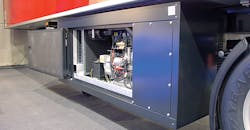Engineers working to limit noise from trucks and trailers
Because of the congestion throughout Western Europe, refrigerated fleets often deliver loads at night when the traffic is reduced. Studies indicate that fleets can reduce delivery times significantly — up to 50% in some cases — by making deliveries in the middle of the night.
In many cases, however, the stores where the deliveries are made have residences built on top of them. Occupants of those residences have complained to their governments, and the issue is getting consideration in several countries in that part of the world.
The Netherlands already has noise regulations in place. The Dutch regulations call for a 60-dbA (decibel) noise limit for refrigerated trailers between 11 pm and 7 am. By comparison, the noise level for a dishwasher in the next room is around 50 dbA.
In the Netherlands, the noise level for refrigerated trailers is measured with an open microphone for a five-minute period.
The regulations address all noise generated by the truck and trailer — not just the engine and refrigeration unit. As such, engineers are studying ways to reduce all types of ambient noise, including the opening and closing of doors, operation of liftgates, and the impact of objects against the sidewalls of the trailer.
The result has been some significant changes in the way refrigerated trailers are manufactured and operated. By way of example, in response to these restrictions, Spanish trailer manufacturer Mirofret has developed its Super Quiet refrigerated trailer. Included as part of the design to repress noise:
-
A Carrier Transicold refrigeration unit installed inside a foam-lined box underneath the trailer. The unit's engine serves as a generator to supply electricity to the electric motors that drive the compressor and the fan.
-
A new liftgate with a redesigned hydraulic system, including a new motor and hoses.
-
A redesigned floor that is smooth and covered with a special coating to reduce the amount of sound generated when the trailer is loaded or unloaded.
-
Composite load bars that produce less noise on impact than comparable products made of metal.
-
A GPS system on the tractor that automatically reduces engine RPM when the truck gets into a predefined area.
-
A backup alarm that emits a frequency that does not travel as far as conventional backup alarm signals.
-
Steerable axles make the trailers more maneuverable.
